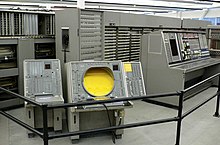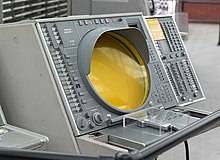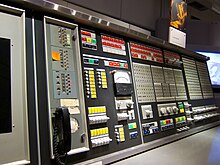| AN/FSQ-7 Combat Direction Central | |
|---|---|
| Part of Semi-Automatic Ground Environment | |
| AL: Gunter Annex (DC-09) AZ: Luke Air Force Base (DC-21) CA: Beale Air Force Base (DC-18) CA: Norton Air Force Base (DC-17) ME: Bangor Air National Guard Base (DC-15) MI: Custer Air Force Station (DC-06) MI: K.I. Sawyer AFB (DC-14) MN: Duluth AFB (DC-10) MO: Richards-Gebaur Air Force Base (DC-08) MT: Malmstrom Air Force Base (DC-20) ME: Topsham Air Force Station (BaADS)(DC-05) ND: Grand Forks Air Force Base (DC-11) ND: Minot Air Force Base (DC-19) NJ: McGuire Air Force Base (DC-01) NV: Stead AFB (DC-16) NY: Hancock Field (Syracuse AFS) (DC-03) NY: Stewart Air Force Base (DC-02) ON: CFB North Bay, Ontario (DC-31) OR: Adair Air Force Station (DC-13) VA: Fort Lee Air Force Station (DC-04) WA: McChord Air Force Base (DC-12) WI: Truax Field (DC-07) in United States | |
 The AN/FSQ-7 included a Maintenance Intercom System (the phone on end of cabinet). The AN/FSQ-7 included a Maintenance Intercom System (the phone on end of cabinet). | |
| Type | Military command, control and coordination system |
| Also known as | Q7 |
|---|---|
| Manufacturer | IBM |
| Generation | 1 |
| Release date | 1955; 70 years ago (1955) |
| CPU | 49,000 vacuum tubes @ 75,000 instructions per second |
| Power | up to 3 megawatts of electricity |
| Weight | 250 tons |
The AN/FSQ-7 Combat Direction Central, referred to as the Q7 for short, was a computerized air defence command and control system. It was used by the United States Air Force for ground-controlled interception as part of the Semi-Automatic Ground Environment network during the Cold War.
The name “AN/FSQ” derives from Army-Navy / Fixed Special eQuipment.
An advancement of the pioneering MIT Whirlwind II digital computer design, and manufactured by IBM as prime contractor, the AN/FSQ-7 was the largest discrete computer system ever built. Each of the 24 installed machines weighed 250 tons. The AN/FSQ-7 used a total of 60,000 vacuum tubes (49,000 in the computers) and up to 3 megawatts of electricity, performing about 75,000 instructions per second for networking regional radars.
Primary functions
Installations in the USAF Semi-Automatic Ground Environment (SAGE) air defense network were configured as duplex systems, using a pair of AN/FSQ-7 computers to provide fault tolerance. One was active at any time, the other on standby. The standby system copied data from the active system to minimize switchover time if needed. A scheduled switchover took place every day.
The AN/FSQ-7 calculated one or more predicted interception points for assigning manned aircraft or CIM-10 Bomarc missiles to intercept an intruder using the Automatic Target and Battery Evaluation (ATABE) algorithm. Also used in the Nike AN/FSG-1 system, ATABE automated the Whiz Wheel (Felsenthal CPU-73 A/P Air Navigation Attack Computer) method used in manual command post operations.
The Q7 fire button launched the Bomarc, and an additional Q7 algorithm automatically directed the missile during climb and cruise to the beginning of its supersonic dive on the target when guidance transferred to the missile seeker system for the homing dive. Later improvements allowed transmission of Q7 guidance to autopilots of manned fighters for vectoring to targets via the SAGE Ground to Air Data Link Subsystem (cf. bomber vectoring to a Bomb Release Point in 1965–1973 Vietnam via vacuum-tube analog computers.)
History
The first United States radar network used voice reporting to the 1939 Twin Lights Station in New Jersey, and the post-World War II experimental Cape Cod System used a Whirlwind I computer at Cambridge, Massachusetts to network long-range and several short-range radars. The key Whirlwind modification for radar netting was the development of magnetic-core memory that vastly improved reliability, doubled operating speed, and quadrupled input speed relative to the original Williams tube memory of the Whirlwind I.
The AN/FSQ-7 was based on the larger and faster (but uncompleted) Whirlwind II design. It proved too much for MIT's resources, resulting in IBM being retained as prime contractor – though the MIT Lincoln Laboratory Division 6 still participated in AN/FSQ-7 development.
Similar to the Q7, the smaller AN/FSQ-8 Combat Control Central was produced without an 'Automatic Initiation Area Discriminator'
A simplex version of the AN/FSQ-7 was located at the premises of the System Development Corporation in Santa Monica, California from 1957 until the premises were vacated some time after 1981.
Uses
SAGE
Main article: Semi-Automatic Ground EnvironmentThe experimental SAGE subsector, located in Lexington, Massachusetts, was completed in 1955, equipped with a prototype AN/FSQ-7 known as XD-1 in Building F. The third evaluation run with the XD-1 was in August and the prototype was complete in October 1955, except for displays.
DC-1 at McGuire Air Force Base was the first operational site of the AN/FSQ-7 with consoles scheduled for delivery Aug–Oct 1956. Groundbreaking at McChord Air Force Base was in 1957 where the "electronic brain" began arriving in November 1958. The Cape Canaveral BOMARC 624-XY1's intercept of a target drone in August 1958 used the Kingston, New York, Q7 1500 miles away. By 1959, the 2000th simulated BOMARC intercept had been completed by the Q7.
The SAGE/Missile Master test program conducted large-scale field testing of the ATABE mathematical model using radar tracks of actual Strategic Air Command and Air Defense Command aircraft conducting mock penetrations into defense sectors (cf. Operation Skyshield). The vacuum-tube SAGE network was completed (and obsolete) in 1963, and a system ergonomic test was performed at Luke Air Force Base in 1964. According to Harold Sackman, it "showed conclusively that the wrong timing of human and technical operations was leading to frequent truncation of the flight path tracking system." Back-Up Interceptor Control Systems (BUIC) were used to replace the AN/FSQ-7s: two remained at SAGE sites until 1983 including McChord AFB, and the Q7 at Luke AFB was demolished in February 1984.
Sabre
The SABRE airline reservation system used AN/FSQ-7 technology.
In popular media
Q7 components were used as props in numerous films and television series needing futuristic-looking computers, despite the fact they were built in the 1950s. Q7 components were used in The Time Tunnel, The Towering Inferno, Logan's Run, WarGames, Independence Day, Planet of the Apes TV series (Season 1, Episode 5, "The Legacy" aired October 1974), and many others.
Today
The Computer History Museum displays several AN/FSQ-7 components.
Equipment



MIT selected IBM as the prime contractor for equipment construction. The Central Computer System of the AN/FSQ-7 had two computers for redundancy each with Arithmetic, Core Memory, Instruction Control, Maintenance Control, Selection & IO Control, and Program elements. The Q7 had input/output devices such as:
- IBM 723 card punch and IBM 713 punched card reader
- IBM 718 line printer (64 print positions)
- drum auxiliary memory (50 "fields" of 2048 words each) and IBM 728 magnetic tape drives (32-bit words)
- Crosstelling Input (XTL) from other AN/FSQ sites
- Display and Warning Light System with dozens of consoles in various rooms having Situation Display Tubes, Digital Display Tubes, and controls (e.g., push buttons and light gun) including:
- Duplex Maintenance Console (two), each DMC operated one of the Central Computer Systems and allowed diagnostics (a speaker was available)
- Tracker Initiator Consoles for designating a "blip" (radar return) to be tracked (assign a track number and to relay speed, direction, and altitude)
- Command Post Digital Display Desk
- Senior Director's keyed console with the Bomarc fire button
- LRI Monitor Console for monitoring Long Range Radar data
- Large Board Projection Equipment Operator displays were directly copied on 35 mm film which were projected on the board.
Punched card data was transferred to and from the core memory as binary images. Only the rightmost 64 columns were transferred, with each row containing two 32-bit words. (The left columns could be punched using a special instruction.) Data were transferred to the line printer as a card image as well.
Core memory element
| This section needs additional citations for verification. Please help improve this article by adding citations to reliable sources in this section. Unsourced material may be challenged and removed. (December 2013) (Learn how and when to remove this message) |
The FSQ-7 and -8 used core memory with 32-bit words plus a parity bit, operating at a 6-microsecond cycle time. Both machines had two banks of memory, memory 1 and memory 2 (Commonly referred to as Big Mem and little Mem). On the FSQ 7 memory 1 had 65,536 words and memory 2 had 4096 words. At Luke Air Force Base, the FSQ-7 held 65,536 words at each bank and the FSQ-8 4096 words at each bank.
For data storage, each word was divided into two halves, each half was a 15-bit number with a sign bit. Arithmetic operations were performed on both halves simultaneously. Each number was treated as a fraction between −1 and 1. This restriction is placed on data primarily so that the multiplication of two numbers will always result in a product smaller than either of the numbers, thus positively avoiding overflow. Properly scaling calculations was the responsibility of the programmer.
Instructions used the right half word plus the left sign bit to form addresses, yielding a 17-bit address space. The remainder of the left half word specified the operation. The first three bits after the sign specified an index register. The following bits specified an instruction class, class variation and instruction-dependent auxiliary information. Addresses were written in octal notation, with the two sign bits forming a prefix, so 2.07777 would be the highest word in memory 2.
Arithmetic registers were provided for both halves of the data word and included an accumulator, an A register that held the data value retrieved from memory, and a B register that held the least significant bits of a multiplication, the magnitude of a division, as well as shifted bits. There was also a program counter, four index registers, and a 16-bit real-time clock register which was incremented 32 times a second. Trigonometric sine and cosine functions used 1.4 degree precision (256 values) via look-up tables.
See also
References
- Murphy, Michael F. "AN/FSQ7 SAGE Computer: Luke AFB". Radomes.org. Archived from the original (personal notes) on March 22, 2012. Retrieved April 2, 2012.
Luke center was unique in the fact that it was the programming center for all other sage sites. This only meant that our computers…had more core memory, 32K total
- ^ In Your Defense (digitized movie). Western Electric. Retrieved April 3, 2012.
The System Development Corporation…in the design of massive computer programs … Burroughs…electronic equipment … Western Electric…assist the Air Force in coordinating and managing the entire effort…and design of buildings. …SAGE project office…Air Material Command
NOTE: The film identifies "Direction Center" versus "Data Center". - Dyson, George (April 1997). Darwin Among the Machines: The Evolution of Global Intelligence (1 ed.). Basic Books. p. 179. ISBN 0-7382-0030-1.
- ^ Hellige, Hans Dieter (February 1993). Actors, Visions and Developments in the History of Computer Communications (PDF) (Report). "Work and Technology" Research Centre. Archived from the original (PDF) on November 16, 2012. Retrieved April 2, 2012.
- ^ Granelia, Mark. "IBM-SAGE-Computer". Archived from the original on March 22, 2012. Retrieved April 2, 2012.
- ^ Bernd Ulmann (August 2014). AN/FSQ-7: the computer that shaped the Cold War. de Gruyter Oldenbourg. ISBN 978-3-486-85670-5.
- ^ The SAGE/BOMARC Air Defense Weapons System (Fact Sheet) (Report). IBM Military Products Division. Retrieved April 2, 2012.
On August 7, 1958, the IBM/SAGE computer at Kingston undertook the first remote-controlled intercept of a drone target by a BOMARC missile. The BOMARC was fired from Cape Canaveral and the intercept was made at sea.
- ^ A Survey and Summary of Mathematical and Simulation Models as Applied to Weapon System Evaluation (Report). Aeronautical Systems Division, USAF. December 1961. Retrieved September 13, 2011.
Future experiments and/or tests: Data from the Phase II and Phase III NORAD SAGE/ Missile Master test program is to be used to validate the mathematical model. These are large-scale system tests employing SAC and ADC aircraft. The field test program is the responsibility of the NORAD Joint Test Force stationed at Stewart Air Force Base.
(cites Miller 1961) - "Whiz Wheel". MobileRadar.org. Retrieved December 24, 2013.
- "sources". MobileRadar.org. Retrieved December 24, 2013.
- ^ DeWerth, John P. …Sage Memories (personal notes) (Report). SMECC.org. Retrieved April 3, 2012.
- compiled by Johnson, Mildred W (December 31, 1980) . A Handbook of Aerospace Defense Organization 1946 – 1980 (PDF). Peterson Air Force Base: Office of History, Aerospace Defense Center. p. . Archived from the original (PDF) on February 13, 2016. Retrieved March 26, 2012.
- ^ Division 6 Staff. Biweekly Report for 27 May 1955 (Memorandum) (Report). MIT Lincoln Laboratory.
{{cite report}}: CS1 maint: numeric names: authors list (link) - "SAGE Cpmputeer Dose Not Render Man Obsolete" (scan). The Evening News (Newburgh). No. 2/111. June 21, 1962. pp. 6–7. Retrieved November 14, 2024 – via Google.news.com.
- ^ Theory of Programming for AN/FSQ-7 combat direction central and AN/FSQ-8 combat control central (PDF) (Report). IBM Military Products Division. April 1, 1959. Retrieved April 2, 2012.
- Introduction to AN/FSQ-7 Combat Direction Central and AN/FSQ-8 Combat Control Central (Ed-Thelen.org transcription) (Report). Kingston, New York: International Business Machines Corporation. Retrieved April 2, 2012.
- "MC 665" (PDF). dome.mit.edu. Retrieved November 29, 2019.
- Division 6 Staff. Biweekly Report for 4 May 1956 (Memorandum) (Report). MIT Lincoln Laboratory.
{{cite report}}: CS1 maint: numeric names: authors list (link) - John Pike. "Semi-Automatic Ground Environment – United States Nuclear Forces". GlobalSecurity.org. Retrieved December 24, 2013.
- "Electronic Brain Slated To Arrive". Tri-City Herald. November 3, 1958. Retrieved April 2, 2012.
- "CBC Digital Archives". CBC.ca. Retrieved December 24, 2013.
- ^ "SAGE A/N FSQ-7". Smecc.org. Retrieved December 24, 2013.
- "SAGE- Phoenix Air Defense Sector & 4629 Support Squadron". Smecc.org. Retrieved December 24, 2013.
- "Computer History". Plyojump. Archived from the original on January 3, 2014. Retrieved December 24, 2013.
- "Starring The Computer". Archived from the original on June 26, 2017. Retrieved January 26, 2020.
- Loewen, Mike (March 13, 2012). "The AN/FSQ-7 on TV and in the Movies". PSU.edu. Archived from the original on May 28, 2012. Retrieved April 2, 2012.
- Bash, Charles J. and others (1986) IBM's Early Computers, MIT, pp.240–248
- Theory of Operation AN/FSQ-7(XD-1, XD-2) Combat Direction Central: Central Computer System (Preliminary Manual) (Report). Poughkeepsie, New York: International Business Machines Company. September 1955. Retrieved April 2, 2012.
introduction of the air defense program … from the Drum System when available and needed. … For more information on the subject of programming, refer to PH 45-00002.
(one of various SAGE documents at BitSavers.org) - ^ "MC 665 info" (PDF). dome.mit.edu. Retrieved November 29, 2019.
- Karculias, Pete. "description of 1967–9 SAGE photographs". SAGE A/N FSQ-7 . Southwest Museum of Engineering, Communications and Computation. Retrieved April 2, 2012.
- "Semi-Automatic Ground Environment (SAGE)". MITRE corporation. Archived from the original on November 3, 2008.
- "MC 665 data" (PDF). dome.mit.edu. Retrieved November 29, 2019.
- Astrahan, Morton M.; Jacobs, John F. (1983). "History of the Design of the SAGE Computer – The AN/FSQ-7" (PDF). Annals of the History of Computing. 5 (4). IEEE: 340–349. doi:10.1109/MAHC.1983.10098. S2CID 14273110.
| External videos | |
|---|---|
External links
- Rowe, H.T. (September 1, 1956). "THE IBM COMPUTER AN/FSQ-7 AND THE ELECTRONIC AIR DEFENSE SYSTEM SAGE ". Computers and Automation: Vol 5 Iss 9. Internet Archive. Berkeley Enterprises. pp. 6–9, 42.
| Records | ||
|---|---|---|
| Preceded byIBM NORC | World's most powerful computer 1958–1959 |
Succeeded byIBM 7090 |
| IBM vacuum tube computers | |
|---|---|
| SAGE | |
- Computer systems of the United States Air Force
- 1955 in computing
- 1955 in military history
- 1958 in military history
- 1983 disestablishments in the United States
- 1983 in military history
- IBM vacuum tube computers
- Missile guidance
- 32-bit computers
- 1955 establishments in Massachusetts
- Military electronics of the United States